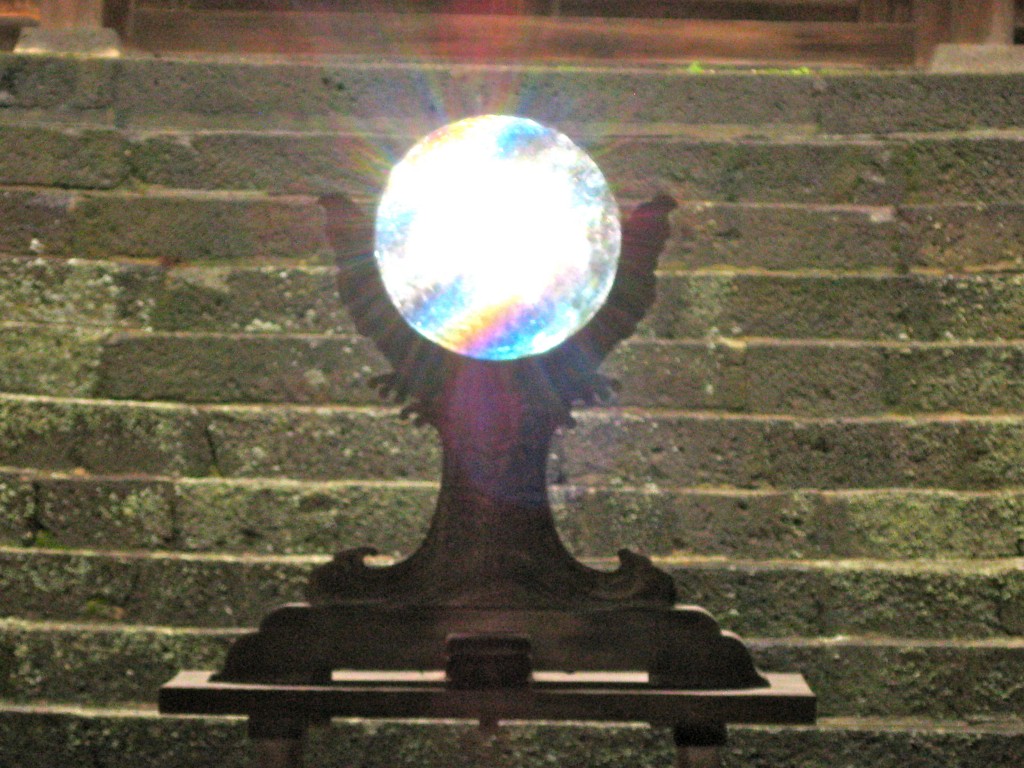
Mirrors play a central part in Shinto, for they are thought to contain the body of the kami. This blog has carried several articles ‘reflecting’ on the special properties of the mirror, and why it would have had a mesmerising effect on bronze-age people. (See here for example.) Recently too we had a feature on the recreation of a magic mirror that might have once belonged to the early empress, Himiko. But what exactly is ‘a magic mirror’?
In its latest online edition, the wonderful Kyoto Journal carries an absorbing article and interview with the last remaining maker of ‘magic mirrors’. Below are extracts; for the more lengthy original article, please see here.
***************************************************************************************************
THE MAGIC MIRROR MAKER
Interview by Jodie Moon with Paul Carty; Translation by Masako Kaidan
Many thanks to Lisa Yamashita Allen for shaping and polishing…
Bronze mirrors
The ancient craft of bronze mirror-making dates back to 2900–2000 BCE in China, Egypt and the Indus Valley. Bronze, a highly-reflective alloy of copper, tin and lead, can be either gold or silver in color. Bronze mirrors became popular and were produced in large quantities during the Han Dynasty (206 BCE–24 AD) in China. Usually circular, they later evolved into a variety of forms, from oblong to octagonal.
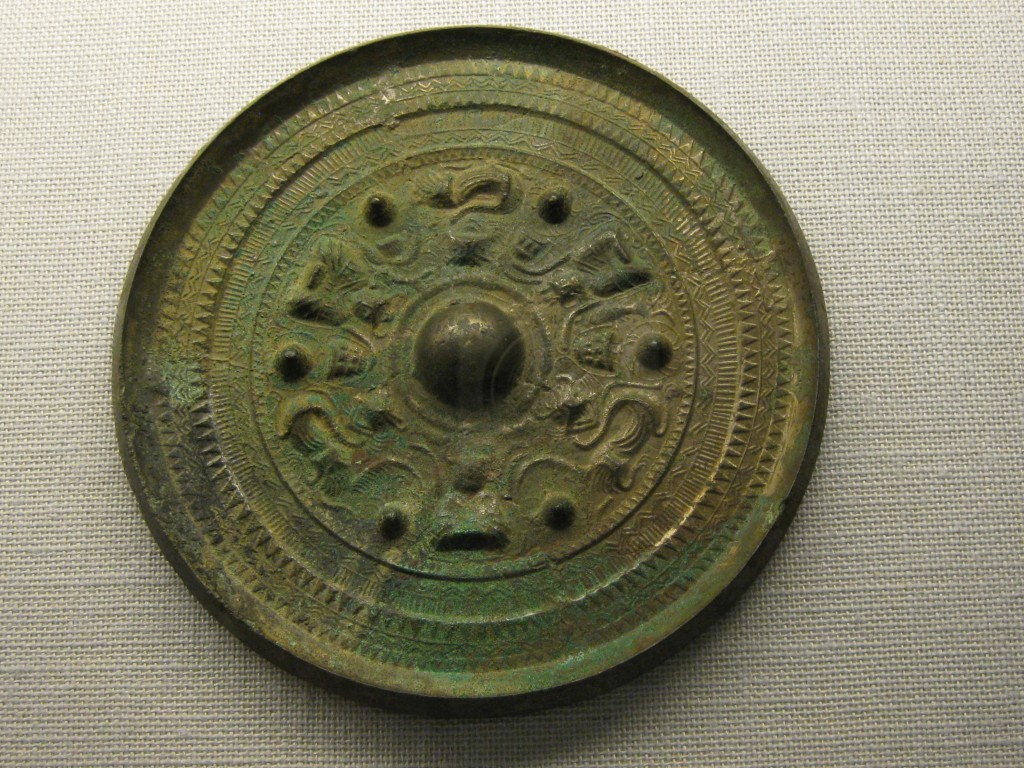
Antique bronze mirror from Kokugakuin museum. The back is often decorated with patterns or plant depictions. They were regarded as sacred because they were thought to hold magical properties.
As use of bronze mirrors became widespread in China, the ancient craft of mirror-making spread to neighboring Korea and Japan. The Emperor Cao Rui and the Wei Court of China reputedly gifted numerous bronze mirrors (then known as shinju-kyo in Japan) to Queen Himiko of Wa (Japan). During excavations of the Kurotsuka kofun (tomb) in Nara, archeologists discovered 33 similar bronze mirrors dating to the 3rd-7th centuries.
In ancient Japan, mirrors were especially revered as rare and mysterious objects. In 1339, Chikafusa Kitabatake wrote (in the Jinno Shotoki) that they were seen as a “source of honesty” because they reflect “everything good and bad, right and wrong… without fail.” In fact, one of Japan’s three most important imperial treasures is a sacred mirror called Yata-no-Kagami.
In a story that is central to Japanese mythology, this bronze mirror was key to coaxing Amaterasu Omikami (the Sun Goddess) out from the cave she had retreated to after a skirmish with her younger brother (Susanoo, the Storm God). (While one deity gave an amusing dance performance, another held up the mirror to deceive her into believing there was another goddess who could outshine her). It is believed that Amaterasu resides in the Yata-no-Kagami, housed today in Ise Shrine, off-limits to the public in Mie Prefecture.
In Japan, some bronze mirrors are known as magic mirrors, or makkyo (魔鏡). One side is brightly polished, while an embossed design decorates the reverse side. Remarkably, when light is directed onto the face of the mirror, and reflected to a flat surface, an image magically appears (usually the one featured on its back). While the metal is completely solid, the reflected image gives the impression that it must be in some way translucent. For many centuries, the ‘magic’ of these mirrors baffled both laymen and scientists.
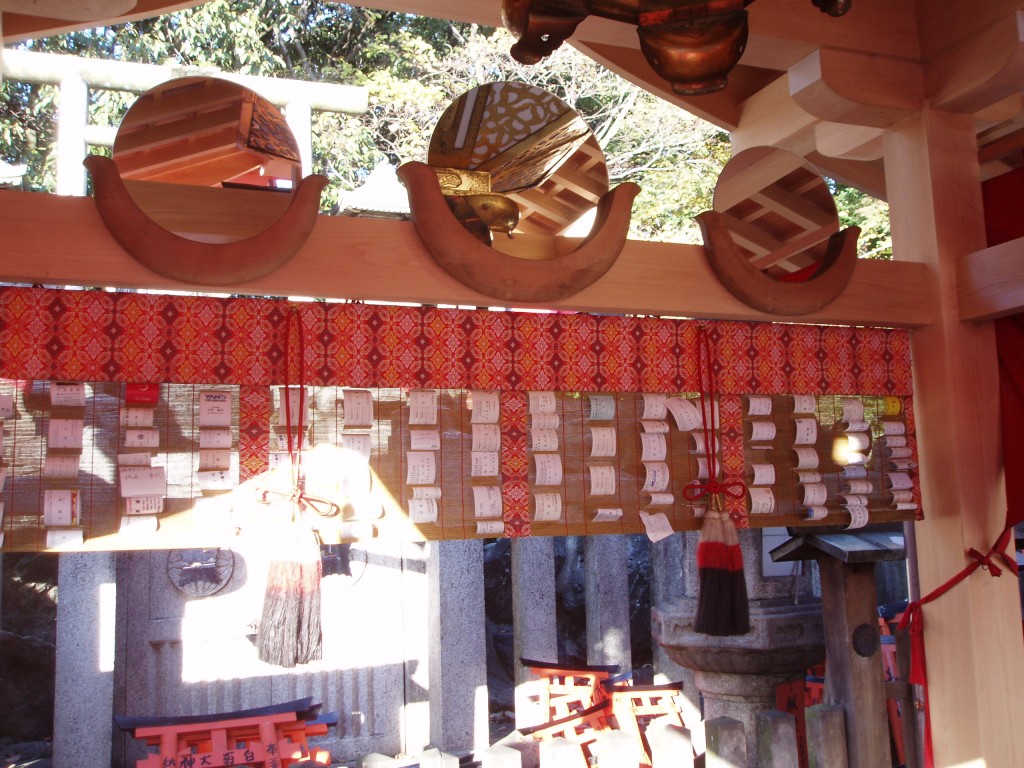
A holy trinity of mirrors in one of Fushimi Inari's countless subshrines
The currently accepted explanation for this phenomenon is that during its construction the mirror’s surface is scraped, scratched, and polished, then coated with an amalgam of mercury, thereby causing stresses and “preferential buckling” into convexities of a scale too small to be observed by the naked eye, but matching the pattern on the back of the mirror.
Kyoto Journal sat down with the man rumored to be the last remaining makkyo maker in the world — Yamamoto Akihisa — and his friend, Yoshida Hisashi. Mr. Yamamoto is descended from a family of mirror makers based in Kyoto. Mr. Yoshida works with Shinto shrines and makes traditional Shinto clothing. They collaborated to organize a fascinating exhibition displaying Mr. Yamamoto’s mirrors in June 2013.
**************************************************************************
YAMAMOTO: When devotional mirrors are displayed in Shinto shrines, they are either hidden from the public eye or placed where they can only be seen from the front. At the exhibition I wanted to give people the opportunity to see both sides of the mirror.
Your company’s mirrors go to both Buddhist temples as well as Shinto shrines, however, I heard that you were a Shinto mirror maker. How would you identify or define yourself and your work?
YOSHIDA: While Shinto is the native religion of Japan, we Japanese have been receptive to other religions, particularly Buddhism. The underlying belief of Shinto is that there are some eight million gods. There’s no real distinction between those eight million gods and Buddha. In other words, religion in Japan is polytheistic, rather than monotheistic. In the same way, there’s no clear distinction between the mirrors for Shinto shrines or Buddhist temples, nor those with the image of Jesus Christ.
They are all religious in nature?
YOSHIDA: Yes, but actually makkyo are rarely sent to Shinto shrines, they are usually sent to private homes.
Makkyo project images, of a saint for example. In Shinto belief, the gods dwell in our natural surroundings, like in trees or stones, which means that there is little imagery of the gods themselves in shrines. Therefore, it’s not appropriate to have makkyo mirrors in Shinto shrines.
YAMAMOTO: For Buddhism, there are many different types of temples. Some temples are a mix of Shinto and Buddhism and have a yashiro [a small shrine in their precincts]. These temples place a mirror inside the honden [the main hall of the temple] or in front of the Buddhist statue.
Mirrors have many uses — they were put in graves, ten mirrors placed around people’s heads, especially in kofun — used as gifts, as religious ceremonial tools and sacred goshintai [“god-dwelling objects”], but why do you think they’re so special? Why do they have this long tradition and so many uses?
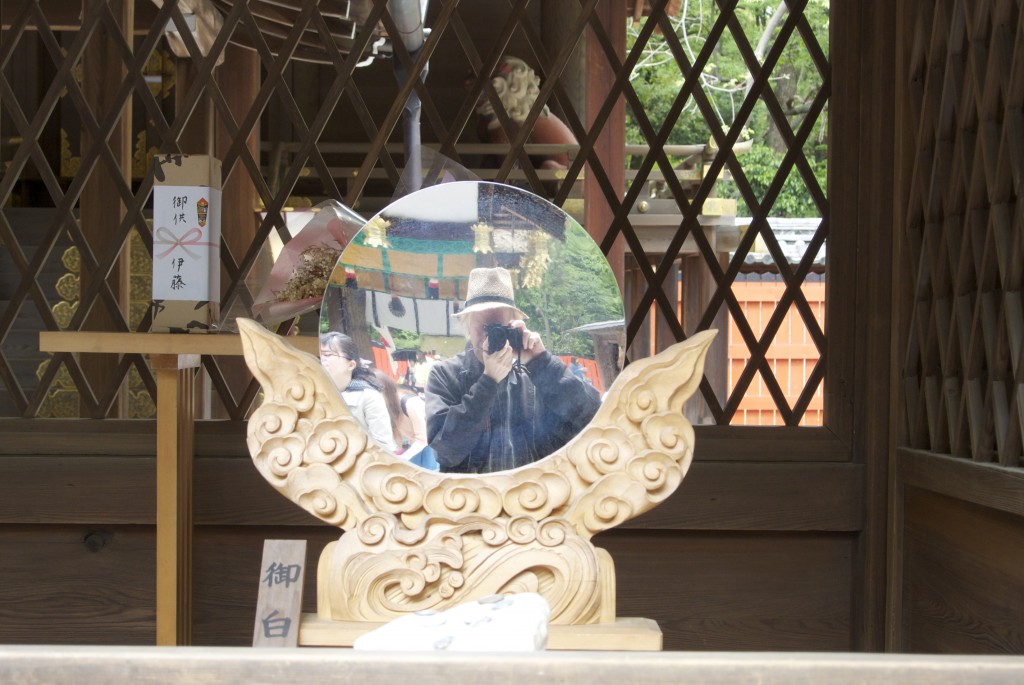
Watching you, watching me.... Altar mirrors are often angled to reflect the spirit of the kami within the person of the onlooker
YOSHIDA: It’s believed that mirrors in Shinto shrines, for example, are placed in cases where people can see their own reflection when they come into the shrines to pray, so that more than about seeing the gods you can see yourself reflected in the mirrors and it becomes about seeing a clear image of yourself.
At the exhibition, you could actually see your face on the back of the mirror. Is there a distinction between mirrors with that reflective quality on the back and mirrors that don’t have that?
YAMAMOTO: The traditional style for a mirror does not have a clear reflection on the back. People from Shinto shrines and Buddhist temples prefer this style because they want to preserve and continue the traditional craft. However, it’s more time consuming and more expensive to make.
When you make a work that’s going to be a goshintai, is it a different process? Is there something you do differently in the case of a sacred object — washing hands or wakanai [praying] — compared to a mirror that might go into a house?
There’s not much of a difference when making mirrors for personal homes or as goshintai. However, when I go to Shinto shrines, I wear shiroshozoku [a white cloth] because it’s being delivered to sacred ground.
When you make a mirror for commission, do your clients specify what they want or do they ask for your ideas?
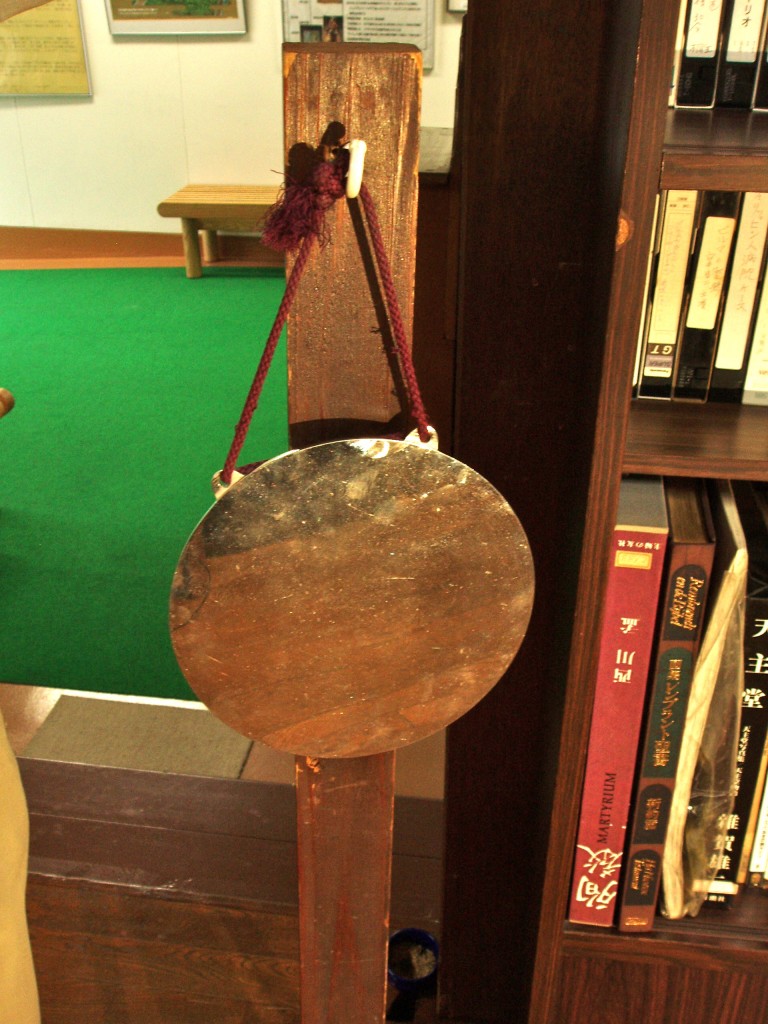
Replica of a Hidden Christian magic mirror. Outwardly it looks like a Shinto mirror, but when a light is shone from a certain angle, an image of the Virgin Mary is reflected on the wall. (In the Franciscan museum, Kyoto)
Both. There are cases where the client says what they want me to make, and there are times where I’m asked to offer my own ideas. When the client wants a special image I ask a painter to make a design and then show it to the client.
Generally, I show my clients many different samples and designs from what I already have and then make a suggestion. This is more common because I already have the molds, so it’s more cost-effective. A new design costs about ten times more, and takes about two to three months to finish because everything has to be made from scratch.
While it’s not very common for me to make the whole thing from the start, I prefer that because then both my technology and my art can evolve. In order to continue and develop my craft, I want to have the opportunity and time to devote to [the whole process of making] one piece. So, it’s kind of a dilemma.
It sounds like there is a different sense or feeling about the craft in your family. Why is it important to you to continue this craft?
I’m not simply making mirrors as a source of income. I believe it is a really important craft and I want to pass my knowledge about the craft on to other people. At the Impact HUB Kyoto exhibition we showed images of Buddha and Jesus Christ. As a Japanese I don’t see the distinction between “that’s Buddhist” or “that’s Christian’ because our culture accepts all religions. I didn’t know how non-Japanese people would see the exhibition, but I think that’s an important thing — to encompass and accept all religions — and that’s probably what the world needs now. And that concept of encompassing and accepting all religions is a story I want to tell through this craft.

I seldom comment, but I so look forward to your posts. Thank you for doing this.
I particularly enjoyed this one.
Thanks again.
~k